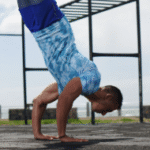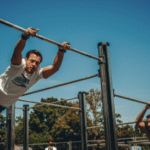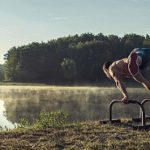Handstand drills for beginners
If you’re in Houston and looking to start your handstand journey, it’s essential to begin with the right drills. Handstand training isn’t just about kicking up against a wall; it’s a process of building foundational strength, core stability, and body awareness. Focusing on these drills will make your handstand practice safer and more effective.
- The Core is Your Foundation: Hollow Body Hold
The hollow body hold is arguably the most important drill for handstand stability. It teaches you to engage your core and keep your spine in a neutral position, which is crucial for a straight handstand line. A weak core is a primary reason why people arch their back and fall.
How to do it: Lie on your back on the floor, pressing your lower back firmly into the ground. Lift your head, shoulders, and legs a few inches off the floor. Keep your arms extended behind you. Your body should form a “C” shape.
Why it works: This position forces your core to work as a single unit, mimicking the muscular engagement you’ll need to maintain a straight line when you’re upside down. Start by holding it for 15-30 seconds and gradually increase your hold time.
- Shoulder Strength and Mobility: Pike Push-Ups
Handstands require significant shoulder strength. Pike push-ups are a great way to build that strength without being fully inverted. They target the shoulders and upper chest, preparing them for the load of your body weight.
How to do it: Start in a downward-facing dog position with your hands shoulder-width apart and your hips high. Your body should look like an inverted “V.” Lower your head towards the floor by bending your elbows, then press back up.
Why it works: This drill directly strengthens the muscles you’ll use to push away from the floor in a handstand. It’s a progressive exercise. You can start with a higher hip position for less resistance and gradually move to a more vertical position as you get stronger.
- Building Confidence Upside Down: Wall Walks
Once you’ve built some foundational strength, it’s time to get comfortable being inverted. Wall walks are a progressive exercise that builds confidence, strength, and body awareness.
How to do it: Start in a push-up position with your feet close to a wall. Walk your feet up the wall as you walk your hands backward, moving closer to the wall. Stop when your chest is close to the wall and hold. Then, reverse the movement to walk back down.
Why it works: Wall walks get you used to the feeling of being upside down and bearing weight on your hands. This drill is excellent for building shoulder and core endurance, and it helps you find the correct alignment for your shoulders, hips, and ankles in a handstand.
- Learning to Balance: The Wall Handstand
The wall handstand is the ultimate tool for learning to balance. It provides the support you need to practice holding a straight line without fear of falling.
How to do it: There are two main ways to approach the wall handstand.
Facing the wall: Walk your hands away from the wall until your body is in a straight line, with your back facing the wall. This is a great way to build confidence.
Belly to the wall: This is the most effective way to learn proper handstand form. Get into a push-up position with your feet near the wall. Walk your feet up the wall and your hands back towards the wall until your body is in a straight line.
Why it works: Belly to the wall forces you to actively engage your core and glutes to prevent your back from arching. This is the exact form you’ll need for a freestanding handstand.
Pro-Tips for Your Houston Handstand Practice
Find a good coach: Many gyms and yoga studios in Houston offer classes focused on inversions. A coach can provide personalized feedback on your form and help you progress safely.
Be consistent: Handstand training is a practice. Consistency is more important than long, infrequent sessions. Aim for 15-20 minutes of drills 3-4 times a week.
Listen to your body: Handstand training puts a lot of stress on your wrists and shoulders. Always warm up properly and take rest days. If you feel pain, stop and rest. You can also incorporate wrist-strengthening exercises into your routine.
Location, location, location: Houston has many excellent parks and outdoor spaces. A flat, grassy area is a great place to practice once you’re comfortable. However, for a beginner, a gym or a home with a sturdy wall is the safest bet.
Starting with these fundamental drills will build a strong base for your handstand. Remember, it’s a journey, and with patience and consistent practice, you’ll be well on your way to a solid handstand

Handstand drills for beginners
Route
Calisthenics Gym Houston Functional Bodyweight Training
Secondary phone: (346) 483-3195
Email: info@calisthenicsclubhouston.com
URL: https://calisthenicsclubhouston.com/
Monday 6:00 AM - 7:00 PM Tuesday 6:00 AM - 7:00 PM Wednesday 6:00 AM - 7:00 PM Thursday 6:00 AM - 7:00 PM Friday 12:00 PM - 6:30 PM Saturday 9:45 AM - 12:00 PM Sunday 3:00 PM - 5:00 PM





